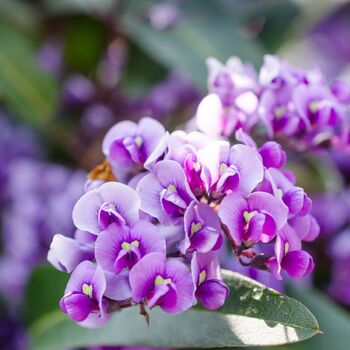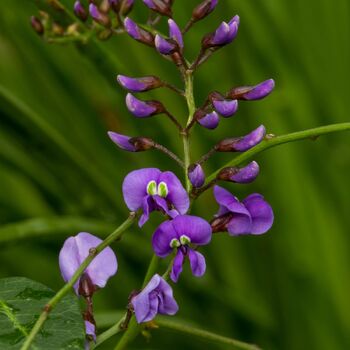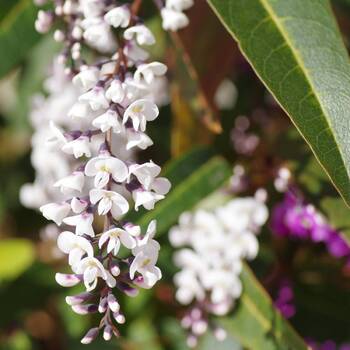
How to Grow Hardenbergia Seeds
Grow Guide #2833
Family: Fabaceae
Binomial name: Hardenbergia sp.
Life Cycle: perennial
This 'How to Grow' guide details everything a home gardener needs to know to plant, grow and care for Hardenbergia (Hardenbergia sp.).
When to Sow Hardenbergia Seeds
Hardenbergia is a perennial plant that grows year round in most climates. Use the table below to identify the best time of year to sow hardenbergia seeds in your climate.
| JAN | FEB | MAR | APR | MAY | JUN | JUL | AUG | SEP | OCT | NOV | DEC | |
|---|---|---|---|---|---|---|---|---|---|---|---|---|
| Cool | ||||||||||||
| Temperate | ||||||||||||
| Sub-Tropical | ||||||||||||
| Tropical | ||||||||||||
| Arid |
Preparation
Hardenbergia plants are best grown in full sun or part shade. Choose a location that will receive at least 3 hours of full sun each day.
Hardenbergia plants are perennial, meaning they live for several years. Choose a permanent position where plants can grow undisturbed by regular digging.
Hardenbergia plants need a well drained soil enriched with plenty of organic matter. Prepare soil by weeding it thoroughly, digging it over to loosen it and adding aged animal manure or compost. Keep the area free of weeds until planting. Learn more about preparing soil for planting here.
How to Sow Hardenbergia Seeds
Soaking seeds prior to planting may improve the speed and success of germination. Soaking seeds in water can help to soften hard seed coats, which can break dormancy and spur the seeds to germinate. Read more about soaking seeds here.
Optional: Smoke treatment is not required for germination, but applying smoke treatment may help seeds to germinate faster. Read more about smoke treatment here.
Hardenbergia seeds grow best when they are raised in trays or other containers and transplanted to the garden once established.
- Fill trays, punnets or jiffy pots with a good quality seed-raising mix, or use soil starter pellets.
- Sow seeds 5mm deep.
- Keep soil moist but never wet or dry.
- Seeds should germinate in around 14-21 days at a soil temperature of 20-22°C.
- Transplant seedlings to the garden once they have their first true leaves and are large enough to handle (usually 5-10cm tall).
- Plant out, spacing plants 200cm apart.
Note: Seeds of many native plants are dormant and will not germinate until ideal environmental conditions are met. Follow instructions for pre-treatment and sowing, and be patient; some wild harvested seeds can take much longer to germinate than expected.
How to Grow Hardenbergia
Hardenbergia plants may need watering during the growing season. Water when the soil is dry about 5cm below the surface (test this by scratching away a little soil with your finger). Water deeply in the early morning or late afternoon. Avoid watering the leaves of plants to avoid fungal diseases. Learn more about watering here.
If soil was well prepared no extra fertiliser should be necessary. In poor soil or to give your plants an extra boost, application of a low-phosphorus fertiliser or one formulated for native plants can be beneficial:
- Apply slow release fertiliser at the recommended rate when transplanting or when seedlings are 5-10cm tall.
- Apply liquid fertiliser at the recommended rate and frequency while plants are fruiting or flowering.
Hardenbergia requires a trellis or other strong support to grow on. Tie plants gently to the support using twine or plant ties. Make sure you have the support in place when you sow seed or transplant seedlings to avoid disturbing the plant’s roots later. Alternatively, hardenbergia can be grown as a sprawling groundcover.
Hardenbergia plants should flower in approximately 350 days.
When plants have finished flowering prune them back to neaten them and encourage strong new growth. Using sharp secateurs or snips, cut individual stems just above a set of lower leaves.
Common Problems when Growing Hardenbergia
Like all plants, hardenbergia is susceptible to some pests, diseases and other problems. Below is a list of the most common problems gardeners encounter when growing hardenbergia plants:
.jpg) Powdery mildew is caused by fungal spores reproducing on the leaves of plants. First showing as white spots on leaves, affected areas can spread quickly to cover the entire leaf surface. While rarely fatal, powdery mildew can reduce yields. Water plants at soil level (not on leaves) to prevent spreading spores, allow good air flow between plants, remove affected leaves and if necessary spray with an appropriate fungicide or homemade spray. Read more here about powdery mildew here.
Powdery mildew is caused by fungal spores reproducing on the leaves of plants. First showing as white spots on leaves, affected areas can spread quickly to cover the entire leaf surface. While rarely fatal, powdery mildew can reduce yields. Water plants at soil level (not on leaves) to prevent spreading spores, allow good air flow between plants, remove affected leaves and if necessary spray with an appropriate fungicide or homemade spray. Read more here about powdery mildew here. Root rot is a disease caused by soil-borne fungi found in wet soil. Plants may be slow to establish, have yellowing or wilted foliage and have soft, brown tissue around the base of the stem and roots. Root rot is often fatal; remove and dispose of affected plants. Reducing soil moisture, adding organic matter to the soil and making sure mulch doesn't touch the stems of plants may help avoid root rot.
Root rot is a disease caused by soil-borne fungi found in wet soil. Plants may be slow to establish, have yellowing or wilted foliage and have soft, brown tissue around the base of the stem and roots. Root rot is often fatal; remove and dispose of affected plants. Reducing soil moisture, adding organic matter to the soil and making sure mulch doesn't touch the stems of plants may help avoid root rot.


.png)






